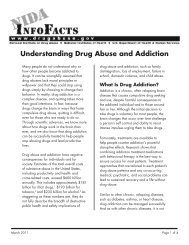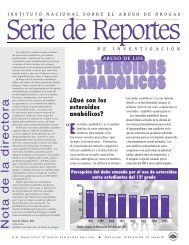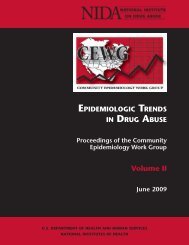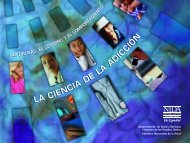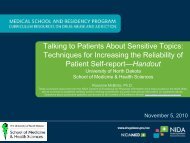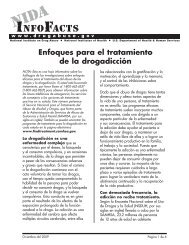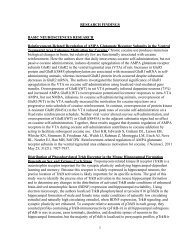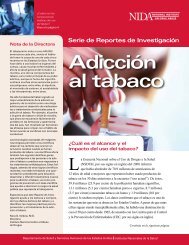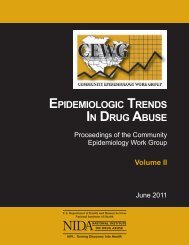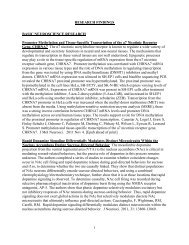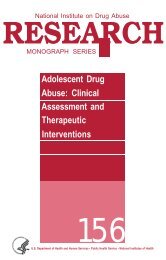CEWG January 09 Full Report - National Institute on Drug Abuse
CEWG January 09 Full Report - National Institute on Drug Abuse
CEWG January 09 Full Report - National Institute on Drug Abuse
You also want an ePaper? Increase the reach of your titles
YUMPU automatically turns print PDFs into web optimized ePapers that Google loves.
Secti<strong>on</strong> III. <str<strong>on</strong>g>CEWG</str<strong>on</strong>g> Area Update Briefs and Internati<strong>on</strong>al Presentati<strong>on</strong>s<br />
first half of 2008. Data <strong>on</strong> drug items identified<br />
in forensic laboratories from drug samples submitted<br />
for analysis were obtained from NFLIS,<br />
DEA, for <str<strong>on</strong>g>January</str<strong>on</strong>g>–June 2008. <strong>Drug</strong> testing results<br />
for law enforcement seizures in King County were<br />
reported by the county where the drug was seized.<br />
Unweighted ED drug reports data were obtained<br />
from DAWN Live!, Offce of Applied Studies, Substance<br />
<strong>Abuse</strong> and Mental Health Services Administrati<strong>on</strong>,<br />
for the first half 2008. Data were accessed<br />
December 22, 2008. Data completeness for the<br />
first half of 2008 (for 25 eligible EDs) was as follows:<br />
11 to 12 of the EDs reported basically complete<br />
data (90 percent or greater) each m<strong>on</strong>th, and<br />
13 to 15 reported no data. <strong>Drug</strong> treatment data<br />
were provided by Washingt<strong>on</strong> State Department<br />
of Social and Health Services, Divisi<strong>on</strong> of Alcohol<br />
and Substance <strong>Abuse</strong>, Treatment <str<strong>on</strong>g>Report</str<strong>on</strong>g> and<br />
Generati<strong>on</strong> Tool from 1999–June 2008. Treatment<br />
modalities included outpatient, intensive inpatient,<br />
recovery house, l<strong>on</strong>g-term residential, and opiate<br />
substituti<strong>on</strong> admissi<strong>on</strong>s. Department of Correcti<strong>on</strong>s<br />
and private-pay admissi<strong>on</strong>s are included.<br />
Methamphetamine incident data were provided<br />
by the Washingt<strong>on</strong> State Department of Ecology for<br />
1990–June 2008.<br />
<strong>Drug</strong> <strong>Abuse</strong> Patterns and Trends in<br />
St. Louis—Update: <str<strong>on</strong>g>January</str<strong>on</strong>g> 20<str<strong>on</strong>g>09</str<strong>on</strong>g><br />
Heidi Israel, Ph.D., M.S.N., LCSW<br />
For inquiries c<strong>on</strong>cerning this report, please c<strong>on</strong>tact<br />
Heidi Israel, Ph.D., M.S.N., LCSW, Assistant Professor,<br />
Orthopaedic Surgery, Saint Louis University<br />
School of Medicine, 3635 Vista, FDT 7 N, St. Louis,<br />
MO 63110, Ph<strong>on</strong>e: 314–577–8851, Fax: 314–268–<br />
5121, E-mail: israelha@slu.edu.<br />
Overview of Findings: Many of the indicators<br />
for the major substances of abuse have<br />
remained relatively stable or were mixed through<br />
the first half of 2008. Alcohol and all drug categories<br />
have shown some increase in treatment<br />
admissi<strong>on</strong>s, but deaths and arrests appear more<br />
stable. Anecdotal informati<strong>on</strong> indicates that heroin<br />
use and availability may have increased as well<br />
as treatment admissi<strong>on</strong>s. While cocaine indicators<br />
have increased in treatment admissi<strong>on</strong>s data,<br />
death data for St. Louis City and County appear<br />
to have stabilized during both 6-m<strong>on</strong>th reporting<br />
periods (death data were reported for the sec<strong>on</strong>d<br />
half of 2007 and the first half of 2008). Prescripti<strong>on</strong><br />
narcotic analgesics were also reported to be<br />
available in the more rural areas of the St. Louis<br />
Metropolitan Statistical Area (MSA). Indicators<br />
for both cocaine and the opiates will need c<strong>on</strong>tinued<br />
m<strong>on</strong>itoring to determine if there have been<br />
changes in these markets or in the user populati<strong>on</strong>s.<br />
Methamphetamine indicators have been<br />
stable in the last 6 m<strong>on</strong>ths.<br />
Updated <strong>Drug</strong> <strong>Abuse</strong> Trends and Emerging<br />
Patterns: Alcohol was the primary drug of<br />
abuse for those entering publicly-funded treatment<br />
programs in Missouri. Treatment admissi<strong>on</strong>s<br />
increased from 2006 to 2007 and again in<br />
2008, and alcohol was frequently indicated as a<br />
sec<strong>on</strong>dary drug of abuse. The Youth Risk Behavioral<br />
Surveillance System (YRBS) survey indicated<br />
no change in lifetime use of alcohol and<br />
cigarettes in 2007, compared with 2005. Cocaine<br />
indicators, in general, were stable over the past<br />
12 m<strong>on</strong>ths. YRBS current cocaine use indicators<br />
were stable in 2007, compared with 2005, while<br />
treatment admissi<strong>on</strong>s and deaths increased in the<br />
last 6 m<strong>on</strong>ths of 2008. Cocaine c<strong>on</strong>tinues to be<br />
St. Louis City’s primary drug problem, and timelier<br />
multiple indicator data are needed to develop<br />
a better picture of the cocaine situati<strong>on</strong> in the<br />
regi<strong>on</strong>. It is believed that Mexican-c<strong>on</strong>trolled distributi<strong>on</strong><br />
chains may be increasing in urban areas<br />
of St. Louis and possibly organizing networks that<br />
c<strong>on</strong>trol distributi<strong>on</strong> of multiple drugs. <str<strong>on</strong>g>Nati<strong>on</strong>al</str<strong>on</strong>g><br />
<strong>Drug</strong> Intelligence Center (NDIC) reports showed<br />
an increase in street prices for crack/cocaine in<br />
2007. The heroin market in the St. Louis Regi<strong>on</strong><br />
has grown and become more complex over the<br />
past few reporting periods. From 2006 to 2007,<br />
treatment admissi<strong>on</strong>s increased by 11.2 percent,<br />
and increased another 44 percent in the first half<br />
of 2008. YRBS lifetime use was stable from 2005<br />
to 2007, at 2.7 percent (95-percent C<strong>on</strong>fidence<br />
Proceedings of the Community Epidemiology Work Group, <str<strong>on</strong>g>January</str<strong>on</strong>g> 20<str<strong>on</strong>g>09</str<strong>on</strong>g> 67



